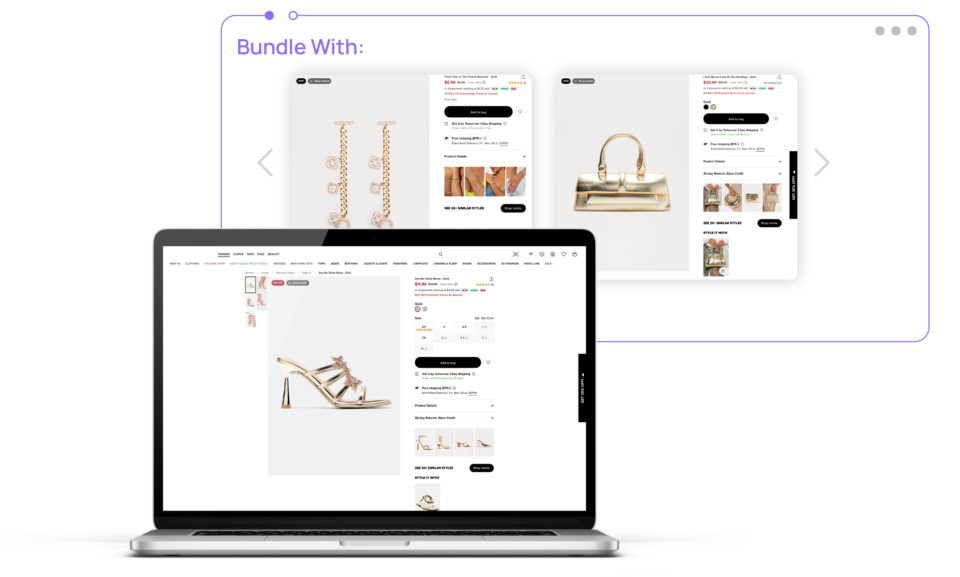Whether it’s back-to-school, Black Friday, or holiday shopping, shoe retailers face unique demands during peak seasons. Customers are often looking for something specific—be it athletic sneakers, winter boots, or stylish heels—and your site’s ability to guide shoppers smoothly from search, discovery, cart, and through to checkout can make all the difference. Here’s how to prepare your online store to convert more customers and meet their needs during your busiest times of year.
1. Optimize Search to Match Customer Intent
The details matter when it comes to shoe shopping. Shoppers know if they need “waterproof hiking boots,” “black leather ankle boots,” or “kids’ running shoes before they even hit your site.” Making sure your search tool can interpret their queries accurately when they get there is the difference between making the sale, or losing them along the way.
Showing similar products keeps shoppers engaged while showcasing more of what you know they’re interested in. For peak season, ensure your search tool can recognize synonyms, style names, and trending keywords. For example, customers who search for “snow boots” should also see “winter boots” and “waterproof boots,” maximizing the likelihood of finding a match.
Create filters for specific attributes, like “comfort,” “wide fit,” or “eco-friendly.” These allow shoppers with particular needs or preferences to locate the perfect pair quickly, providing a tailored shopping experience that feels like it’s built just for them.

2. Highlight Bundles and Accessories to Increase AOV
During peak shoe shopping seasons, many customers are ready to invest a bit more to cover everyone on their list. This makes bundling and cross-selling accessories an effective way to increase average order value (AOV). Consider offering bundles that pair popular shoes with accessories, like socks or shoe care kits, or suggest insoles for athletic shoes.
Retailers who use terms like “Complete the Look” for bundled items or accessories tend to see a boost in AOV, as customers enjoy getting everything they need in one go. For instance, pairing boots with weatherproofing sprays or sneakers with performance socks can encourage add-on purchases.
3. Use Seasonal Merchandising to Keep Your Store Fresh
Your homepage is often the first thing shoppers see, so use it to feature your best seasonal styles. Create curated collections based on popular seasonal themes, like “Holiday Must-Haves,” “Winter Warmers,” or “Spring-break Essentials.” These collections not only make it easier for customers to browse but also give your store a timely, relevant feel.
4. Offer Personalized Recommendations Based on Shopping Behavior
Personalization goes a long way in the shoe industry, especially when customers are browsing high-consideration categories. Use tools that allow for personalized product recommendations based on a customer’s browsing history, previous purchases, or preferences. For example, if a customer has been browsing running shoes, they might also appreciate seeing compression socks or sportswear.
For returning customers, show a “Recently Viewed” section on the homepage. This helps them pick up where they left off, making it easy to revisit items they’re considering, especially during a busy shopping season when they may have limited time to browse.
5. Streamline Checkout to Capture Those Last-Minute Shoppers
Peak season brings in last-minute shoppers looking for a quick, convenient experience. A streamlined checkout process is essential to avoid cart abandonment and ensure customers feel they are quickly taking strides to their purchase showing up doorstep.
Make sure your checkout page is optimized with clear calls-to-action, guest checkout options, and minimal steps to complete a purchase. Highlight any shipping deadlines prominently, so shoppers can feel confident their items will arrive on time. If you offer perks like free shipping, display these benefits clearly to avoid any second-guessing at checkout.
6. Leverage Data to Drive Flash Sales and Limited-Time Offers
The busiest shopping seasons are prime times for flash sales and limited-time discounts, as customers are already in a buying mindset. Use data insights from Searchspring to identify your most-viewed or best-selling items and create campaigns around them. For instance, if a certain sneaker style is trending, launch a 24-hour sale to drive even more site engagement.
Create a countdown timer on your site for flash sales, reminding shoppers that time is limited. This sense of urgency can increase conversions, particularly during high-traffic seasons when competition is fierce.
Conclusion
With the right preparation, your footwear site can stride confidently into any peak shopping season. From optimized search to seasonal collections and personalized recommendations, these strategies can enhance your customers’ shopping experience while boosting your bottom line. By focusing on making the journey from browsing to checkout as smooth as possible, you’re setting your store up for a successful, high-converting season.




